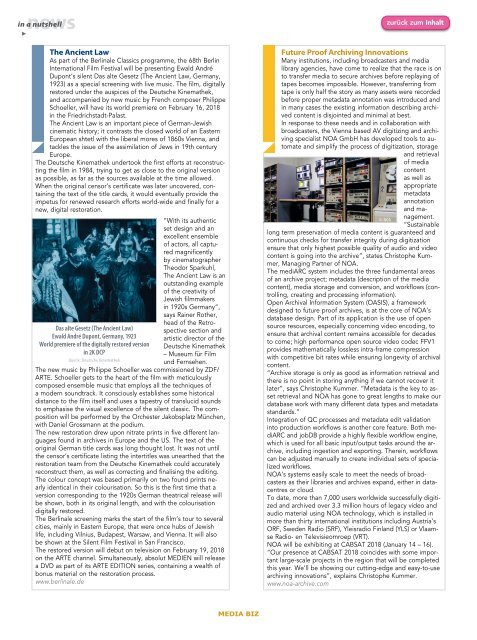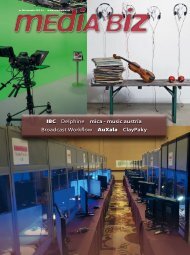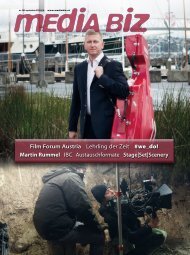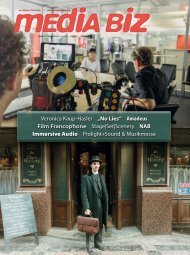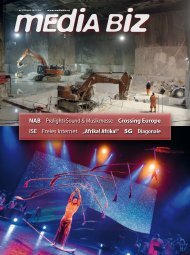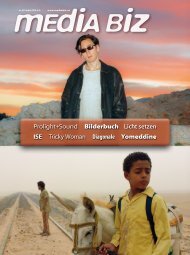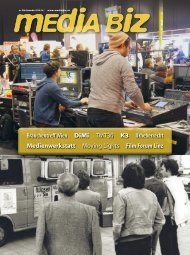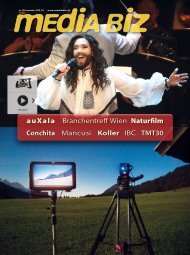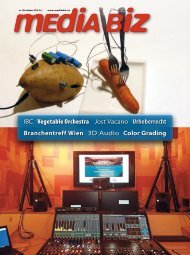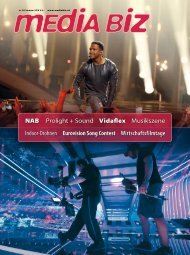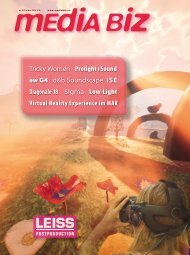MEDIA BIZ 227
MEDIA BIZ, the Austrian magazine focussing on the professional AV industry, covers all aspects of the audio-visual industry with tips and reports on applications and installations, interviews, the latest industry trends, technologies and products concerning film & video, broadcast, IT, professional audio, music, (live) events, digital media, gaming, videoconferencing, digital signage, presentations, etc. Focussing equally on both audio and video products and applications, MEDIA BIZ is aimed at engineers and technicians and other staff and management personnel in the field of broadcasting and digital communications, show and theatre production, post-production, video studios and recording studios, event organizers as well as at agencies, hire-companies, installation companies, resellers, freelancers and end-users working in the professional AV industry. MEDIA BIZ - Fachmagazin & Plattform für Medien- & Kulturschaffende im deutschsprachigen Raum – informiert seit mehr als 20 Jahren die AV-Branche mit Trend-, Anwender-, Best-Practice-, Test- & Messeberichten, Interviews, Expertentipps, sozialkritischen Beiträgen & Impulsen aus den Bereichen Film, Video, Audio, Broadcast, IT, Multimedia, Bühne, Musik, Gaming oder Digital Signage. Ergänzend zum fachspezifischen Teil schlägt MEDIA BIZ die Brücke von Profis zu Film- und Musikfans und allen an Kultur Interessierten mit spannenden Einblicken hinter die Kulissen und Berichten über Produktionen, Projekte und Produkte der Entertainmentbranche und deren Protagonisten. Das Autorenteam von MEDIA BIZ besteht aus erfahrenen Journalisten und Journalistinnen und Experten und Expertinnen aus den jeweiligen Bereichen, darunter etablierte Filmproduzenten und engagierte Indie-Filmer, Kameraleute, Cutter, Tonmeister, passionierte Filmpublizisten, DJs, Vortragende und Lehrende an Universitäten und anerkannten Bildungsinstitutionen, auf die Branche spezialisierte Steuer- und Wirtschaftsexperten oder Techniker. www.mediabiz.at, www.facebook.com/MEDIABIZ.at
MEDIA BIZ, the Austrian magazine focussing on the professional AV industry, covers all aspects of the audio-visual industry with tips and reports on applications and installations, interviews, the latest industry trends, technologies and products concerning film & video, broadcast, IT, professional audio, music, (live) events, digital media, gaming, videoconferencing, digital signage, presentations, etc.
Focussing equally on both audio and video products and applications, MEDIA BIZ is aimed at engineers and technicians and other staff and management personnel in the field of broadcasting and digital communications, show and theatre production, post-production, video studios and recording studios, event organizers as well as at agencies, hire-companies, installation companies, resellers, freelancers and end-users working in the professional AV industry.
MEDIA BIZ - Fachmagazin & Plattform für Medien- & Kulturschaffende im deutschsprachigen Raum – informiert seit mehr als 20 Jahren die AV-Branche mit Trend-, Anwender-, Best-Practice-, Test- & Messeberichten, Interviews, Expertentipps, sozialkritischen Beiträgen & Impulsen aus den Bereichen Film, Video, Audio, Broadcast, IT, Multimedia, Bühne, Musik, Gaming oder Digital Signage.
Ergänzend zum fachspezifischen Teil schlägt MEDIA BIZ die Brücke von Profis zu Film- und Musikfans und allen an Kultur Interessierten mit spannenden Einblicken hinter die Kulissen und Berichten über Produktionen, Projekte und Produkte der Entertainmentbranche und deren Protagonisten.
Das Autorenteam von MEDIA BIZ besteht aus erfahrenen Journalisten und Journalistinnen und Experten und Expertinnen aus den jeweiligen Bereichen, darunter etablierte Filmproduzenten und engagierte Indie-Filmer, Kameraleute, Cutter, Tonmeister, passionierte Filmpublizisten, DJs, Vortragende und Lehrende an Universitäten und anerkannten Bildungsinstitutionen, auf die Branche spezialisierte Steuer- und Wirtschaftsexperten oder Techniker.
www.mediabiz.at, www.facebook.com/MEDIABIZ.at
Erfolgreiche ePaper selbst erstellen
Machen Sie aus Ihren PDF Publikationen ein blätterbares Flipbook mit unserer einzigartigen Google optimierten e-Paper Software.
in a news<br />
nutshell<br />
zurück zum Inhalt<br />
The Ancient Law<br />
As part of the Berlinale Classics programme, the 68th Berlin<br />
International Film Festival will be presenting Ewald André<br />
Dupont‘s silent Das alte Gesetz (The Ancient Law, Germany,<br />
1923) as a special screening with live music. The film, digitally<br />
restored under the auspices of the Deutsche Kinemathek,<br />
and accompanied by new music by French composer Philippe<br />
Schoeller, will have its world premiere on February 16, 2018<br />
in the Friedrichstadt-Palast.<br />
The Ancient Law is an important piece of German-Jewish<br />
cinematic history; it contrasts the closed world of an Eastern<br />
European shtetl with the liberal mores of 1860s Vienna, and<br />
tackles the issue of the assimilation of Jews in 19th century<br />
Europe.<br />
The Deutsche Kinemathek undertook the first efforts at reconstructing<br />
the film in 1984, trying to get as close to the original version<br />
as possible, as far as the sources available at the time allowed.<br />
When the original censor’s certificate was later uncovered, containing<br />
the text of the title cards, it would eventually provide the<br />
impetus for renewed research efforts world-wide and finally for a<br />
new, digital restoration.<br />
Das alte Gesetz (The Ancient Law)<br />
Ewald André Dupont, Germany, 1923<br />
World premiere of the digitally restored version<br />
in 2K DCP<br />
Quelle: Deutsche Kinemathek<br />
“With its authentic<br />
set design and an<br />
excellent ensemble<br />
of actors, all captured<br />
magnificently<br />
by cinematographer<br />
Theodor Sparkuhl,<br />
The Ancient Law is an<br />
outstanding example<br />
of the creativity of<br />
Jewish filmmakers<br />
in 1920s Germany“,<br />
says Rainer Rother,<br />
head of the Retrospective<br />
section and<br />
artistic director of the<br />
Deutsche Kinemathek<br />
– Museum für Film<br />
und Fernsehen.<br />
The new music by Philippe Schoeller was commissioned by ZDF/<br />
ARTE. Schoeller gets to the heart of the film with meticulously<br />
composed ensemble music that employs all the techniques of<br />
a modern soundtrack. It consciously establishes some historical<br />
distance to the film itself and uses a tapestry of translucid sounds<br />
to emphasise the visual excellence of the silent classic. The composition<br />
will be performed by the Orchester Jakobsplatz München,<br />
with Daniel Grossmann at the podium.<br />
The new restoration drew upon nitrate prints in five different languages<br />
found in archives in Europe and the US. The text of the<br />
original German title cards was long thought lost. It was not until<br />
the censor’s certificate listing the intertitles was unearthed that the<br />
restoration team from the Deutsche Kinemathek could accurately<br />
reconstruct them, as well as correcting and finalising the editing.<br />
The colour concept was based primarily on two found prints nearly<br />
identical in their colourisation. So this is the first time that a<br />
version corresponding to the 1920s German theatrical release will<br />
be shown, both in its original length, and with the colourisation<br />
digitally restored.<br />
The Berlinale screening marks the start of the film’s tour to several<br />
cities, mainly in Eastern Europe, that were once hubs of Jewish<br />
life, including Vilnius, Budapest, Warsaw, and Vienna. It will also<br />
be shown at the Silent Film Festival in San Francisco.<br />
The restored version will debut on television on February 19, 2018<br />
on the ARTE channel. Simultaneously, absolut MEDIEN will release<br />
a DVD as part of its ARTE EDITION series, containing a wealth of<br />
bonus material on the restoration process.<br />
www.berlinale.de<br />
© NOA<br />
Future Proof Archiving Innovations<br />
Many institutions, including broadcasters and media<br />
library agencies, have come to realize that the race is on<br />
to transfer media to secure archives before replaying of<br />
tapes becomes impossible. However, transferring from<br />
tape is only half the story as many assets were recorded<br />
before proper metadata annotation was introduced and<br />
in many cases the existing information describing archived<br />
content is disjointed and minimal at best.<br />
In response to these needs and in collaboration with<br />
broadcasters, the Vienna based AV digitizing and archiving<br />
specialist NOA GmbH has developed tools to automate<br />
and simplify the process of digitization, storage<br />
and retrieval<br />
of media<br />
content<br />
as well as<br />
appropriate<br />
metadata<br />
annotation<br />
and management.<br />
“Sustainable<br />
long term preservation of media content is guaranteed and<br />
continuous checks for transfer integrity during digitization<br />
ensure that only highest possible quality of audio and video<br />
content is going into the archive”, states Christophe Kummer,<br />
Managing Partner of NOA.<br />
The mediARC system includes the three fundamental areas<br />
of an archive project; metadata (description of the media<br />
content), media storage and conversion, and workflows (controlling,<br />
creating and processing information).<br />
Open Archival Information System (OASIS), a framework<br />
designed to future proof archives, is at the core of NOA’s<br />
database design. Part of its application is the use of open<br />
source resources, especially concerning video encoding, to<br />
ensure that archival content remains accessible for decades<br />
to come; high performance open source video codec FFV1<br />
provides mathematically lossless intra-frame compression<br />
with competitive bit rates while ensuring longevity of archival<br />
content.<br />
“Archive storage is only as good as information retrieval and<br />
there is no point in storing anything if we cannot recover it<br />
later”, says Christophe Kummer. “Metadata is the key to asset<br />
retrieval and NOA has gone to great lengths to make our<br />
database work with many different data types and metadata<br />
standards.”<br />
Integration of QC processes and metadata edit validation<br />
into production workflows is another core feature. Both mediARC<br />
and jobDB provide a highly flexible workflow engine,<br />
which is used for all basic input/output tasks around the archive,<br />
including ingestion and exporting. Therein, workflows<br />
can be adjusted manually to create individual sets of specialized<br />
workflows.<br />
NOA’s systems easily scale to meet the needs of broadcasters<br />
as their libraries and archives expand, either in datacentres<br />
or cloud.<br />
To date, more than 7,000 users worldwide successfully digitized<br />
and archived over 3.3 million hours of legacy video and<br />
audio material using NOA technology, which is installed in<br />
more than thirty international institutions including Austria’s<br />
ORF, Sweden Radio (SRF), Yleisradio Finland (YLS) or Vlaamse<br />
Radio- en Televisieomroep (VRT).<br />
NOA will be exhibiting at CABSAT 2018 (January 14 – 16).<br />
“Our presence at CABSAT 2018 coincides with some important<br />
large-scale projects in the region that will be completed<br />
this year. We’ll be showing our cutting-edge and easy-to-use<br />
archiving innovations”, explains Christophe Kummer.<br />
www.noa-archive.com<br />
<strong>MEDIA</strong> <strong>BIZ</strong>


